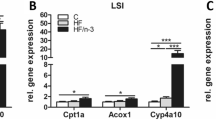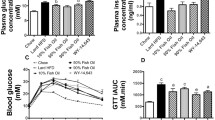Abstract
To study the mechanisms responsible for the hypotriglyceridemic effect of marine oils, we monitored the effects of high dietary intake of n−3 PUFA on hepatic and muscular β-oxidation, plasma leptin concentration, leptin receptor gene expression, and in vivo insulin action. Two groups of male Wistar rats were fed either a high-fat diet [28% (w/w) of saturated fat] or a high-fat diet containing 10% n−3 PUFA and 18% saturated fat for 3 wk. The hypotriglyceridemic effect of n−3 PUFA was accompanied by increased hepatic oxidation of palmitoyl-CoA (125%, P<0.005) and palmitoyl-l-carnitine (480%, P<0.005). These findings were corroborated by raised carnitine palmitoyltransferase-2 activity (154%, P<0.001) and mRNA levels (91%, P<0.01) as well as by simultaneous elevation of hepatic peroxisomal acyl-CoA oxidase activity (144%, P<0.01) and mRNA content (82%, P<0.05). In contrast, hepatic carnitine palmitoyltransferase-1 activity remained unchanged despite a twofold increased mRNA level after n−3 PUFA feeding. Skeletal muscle FA oxidation was less affected by dietary n−3 PUFA, and the stimulatory effect was found only in peroxisomes. Dietary intake of n−3 PUFA was followed by increased acyl-CoA oxidase activity (48%, P<0.05) and mRNA level (83%, P<0.05) in skeletal muscle. The increased FA oxidation after n−3 PUFA supplementation of the high-fat diet was accompanied by lower plasma leptin concentration (−38%, P<0.05) and leptin mRNA expression (−66%, P<0.05) in retroperitoneal adipose tissue, and elevated hepatic mRNA level for the leptin receptor Ob-Ra (140%, P<0.05). Supplementation of the high-fat diet with n−3 PUFA enhanced in vivo insulin sensitivity, as shown by normalization of the glucose infusion rate during euglycemic hyperinsulinemic clamp.
Our results indicate that the hypotriglyceridemic effect of dietary n−3 PUFA is associated with stimulation of FA oxidation in the liver and to a smaller extent in skeletal muscle. This may ameliorate dyslipidemia, tissue lipid accumulation, and insulin action, in spite of decreased plasma leptin level and leptin mRNA in adipose tissue.
Similar content being viewed by others
Abbreviations
- AOX:
-
acyl-CoA oxidase
- CPT-1/-2:
-
carnitine palmitoyltransferase-1 and-2
- EHC:
-
euglycemic hyperinsulinemic clamp
- DHA:
-
docosahexaenoic acid
- EPA:
-
elcosapentaenoic acid
- FA:
-
fatty acid
- G3PDH:
-
glyceraldehyde 3 phosphate dehydrogenase
- HDT:
-
β-oxidation multienzyme complex composed of 2-enoyl-acyl-CoA hydratase, 3-hydroxyacyl-CoA dehydrogenase, and 3-oxoacyl-CoA thiolase
- HF:
-
high-fat
- HF/n−3:
-
n−3 PUFA-supplemented HF diet
- PUFA:
-
polyunsaturated FA
- RT:
-
reverse transcription
References
Sebokova, E., and Klimes, I. (1997) Molecular and Cellular Determinants of Triglyceride Availability, Ann. NY Acad. Sci. 827, 200–214.
Harris, W.S., Hustvedt, B.-E., Hagen, E., Green, G.H., Lu, G., and Drevon, C.A. (1997) n−3 Fatty Acids and Chylomicron Metabolism in the Rat, J. Lipid Res. 38, 503–515.
Storlien, L.H., Kreagen, E.W., Chisholm, D.J., Ford, G.L., Bruce, D.G., and Pascoe, W.S. (1987) Fish Oil Prevents Insulin Resistance Induced by High-Fat Feeding in Rats, Science 237, 885–888.
Klimes, I., Sebokova, E., and Minchenko, A. (1991) Dietary Fish Oil in Hyperlipidemia and Impaired Insulin Action—The Experimental Approach, A Minireview, in Lipoproteins and Atherosclerosis (Hanefeld, M., Jaross, W., and Dude, H., eds.), pp. 56–62, Fisher Verlag, Jena, Germany
Clarke, S.D., and Jump, D.B. (1996) Polyunsaturated Fatty Acid Regulation of Hepatic Gene Transcription, Lipids 31, S7-S11.
Sebökova, E., Klimes, I., Gasperikova, D., Bohov, P., Langer, P., Lavau, M., and Clandinin, M.T. (1996) Regulation of Gene Expression for Lipogenic Enzymes in the Liver and Adipose Tissue of Hereditary Hypertriglyceridemic, Insulin Resistant Rats: Effect of Dietary Sucrose and Marine Fish Oil, Biochim. Biophys. Acta 1303, 56–62.
Rustan, A.C., Hustvedt, B.E., and Drevon, C.A. (1993) Dietary Supplementation of Very Long Chain n−3 Fatty Acids Decreases Whole Body Lipid Utilization in the Rat, J. Lipid Res. 34, 1299–1309.
Drevon, C.A., and Rustan, A.C. (1994) VLDL Metabolism and n−3 Fatty Acids, World Rev. Nutr. Diet. 76, 26–29.
Rustan, A.C., Hustvedt, B.E., and Drevon, C.A. (1998) Post-prandial Decrease in Plasma Unesterified Fatty Acids During n−3 Fatty Acid Feeding Is Not Caused by Accumulation of Fatty Acids in Adipose Tissue, Biochim. Biophys. Acta 1390, 245–257.
Halvorsen, B., Rustan, A.C., Madsen, L., Reseland, J., Berge, R.K., Sletnes, J., and Christiansen, E.N. (2001) Effects of Long Chain Monounsaturated and n−3 Fatty Acids on Fatty Acid Oxidation and Lipid Composition in Rats, Ann. Nutr. Metab. 45, 30–37.
Ide, T., Kobayashi, H., Ashakumary, L., Rouyer, I.A., Takahashi, Y., Aoyama, T., Hashimoto, T., and Mizugaki, M. (2000) Comparative Effects of Perilla and Fish Oils on the Activity and Gene Expression of Fatty Acid Oxidation Enzymes in Rat Liver, Biochim. Biophys. Acta 1485, 23–35.
Madsen, L., and Berge, R.K. (1999) 3-Thia Fatty Acid Treatment, in Contrast to Eicosapentaenoic Acid and Starvation, Induces Gene Expression of Carnitine Palmitoyltransferase-II in Rat Liver, Lipids 34, 447–456.
Kelley, D.E., and Goodpaster, B.H. (2001) Skeletal Muscle Triglyceride: An Aspect of Regional Adiposity and Insulin Resistance, Diabetes Care 24, 933–941.
Baillie, R.A., Takada, R., Nakamura, M., and Clarke, S.D. (1999) Co-ordinate Induction of Peroxisomal Acyl-CoA Oxidase and UCP-3 by Dietary Fish Oil: A Mechanism for Decreased Body Fat Deposition, Prostaglandins Leukot. Essent. Fatty Acids 60, 351–356.
Shimabukuro, M., Koyama, K., Chen, G., Wang, M.-Y., Trieu, F., Lee, Y., Newgard, C.B., and Unger, R.H. (1997) Direct Antidiabetic Effect of Leptin Through Triglyceride Depletion of Tissues, Proc. Natl. Acad. Sci USA 94, 4637–4641.
Unger, R.H., Zhou, Y.T., and Orci, L. (1999) Regulation of Fatty Acid Homeostasis in Cells: Novel Role of Leptin, Proc. Natl. Acad. Sci. USA 96, 2327–2332.
Unger, R.H., and Zhou, Y.T. (2001) Lipotoxicity of β-Cells in Obesity and in Other Causes of Fatty Acid Spillover, Diabetes 50, S118-S121.
Kakuma, T., Lee, Y., Higa, M., Wang, Z.-W., Pan, W., Shimomura, I., and Unger, R.H. (2000) Leptin, Troglitazone and Expression of Sterol Regulatory Element Binding Proteins in Liver and Pancreatic Islets, Proc. Natl. Acad. Sci. USA 97, 8536–8541.
Zhou, Y.T., Shimabukuro, M., Wang, M.Y., Lee, Y., Higa, M., Milburn, J.L., Newgard, C.B., and Unger, R.H. (1998) Role of Peroxisome Proliferator-Activated Receptor α in Disease of Pancreatic β Cells, Proc. Natl. Acad. Sci. USA 95, 18898–18903.
MacDouglas, O.A., Hwang, C.S., and Fan, H. (1995) Regulated Expression of the Obese Gene Product (leptin) in White Adipose Tissue and 3T3-L1 Adipocytes, Proc. Natl. Acad. Sci. USA 92, 9034–9037.
Caro, J., Sinha, M., and Kolaczynski, J. (1996) Leptin: The Tale of an Obesity Gene, Diabetes 45, 1455–1462.
Masuzaki, H., Ogawa, Y., and Hosoda, K. (1995) Augmented Expression of the Obese Gene in the Adipose Tissue from Rats Fed High Fat Diet, Biochem. Biophys. Res. Commun. 216, 355–358.
Raclot, T., Groscolas, R., Langin, D., and Ferre, P. (1997) Site-Specific Regulation of Gene Expression by n−3 Polyunsaturated Fatty Acids in Rat White Adipose Tissues, J. Lipid Res. 38, 1963–1972.
Reseland, J.E., Haugen, F., Hollung, K., Solvoll, K., Halvorsen, B., Brude, I., Nenseter, M.S., Christiansen, E.N., and Drevon, C.A. (2001) Reduction of Leptin Gene Expression by Dietary Polyunsaturated Fatty Acids, J. Lipid Res. 42, 743–750.
Peyron Caso, E., Taverna, M., Guerre-Millo, M., Veronese, A., Pacher, N., Slama, G., and Rizkalla, S.W. (2002) Dietary (n−3) Polyunsaturated Fatty Acids Up-regulate Plasma Leptin in Insulin-Resistant Rats, J. Nutr. 132, 2235–2240.
Storlien, L.H., Pan, D.A., Kriketos, A.D., and Baur, L.A. (1993) High Fat Diet-Induced Insulin Resistance: Lessons and Implications from Animal Studies, Ann. N.Y. Acad. Sci. 683, 82–90.
Kraegen, E.W., Clark, P.W., Jenkins, A.B., Daley, E.A., Chisholm, D.J., and Storlien, L.H. (1991) Development of Muscle Insulin Resistance After Liver Insulin Resistance in High Fat Fed Rats, Diabetes 40, 1397–1403.
Klimes, I., Mitkova, A., Gasperikova, D., Ukropec, J., Liska, B., Bohov, P., Stanek, J., and Sebokova, E. (1998) The Effect of the New Oral Hypoglycemic Agent A-4166 on Glucose Turnover in the High Fat Diet Induced and/or in the Hereditary Insulin Resistance of Rats, Arch. Physiol. Biochem. 106, 325–332.
Chomczynski, P., and Sacchi, N. (1987) Single-Step Method for RNA Isolation by Acid Guanidinium Thiocyanate-Phenol-Chloroform Extraction, Anal. Biochem. 162, 156–159.
Willumsen, N., Hexeberg, S., Skorve, J., Lundquist, M., and Berge, R.K. (1993) Docosahexaenoic Acid Shows No Triglyceride-Lowering Effects but Increases the Peroxisomal Fatty Acid Oxidation in Liver of Rats, J. Lipid Res. 34, 13–22.
Bremer, J. (1981) The Effect of Fasting on the Activity of Liver Carnitine Palmitoyltransferase and Its Inhibition by Malonyl-CoA, Biochim. Biophys. Acta 665, 628–631.
Souri, M., Aoyama, T., and Hashimoto, T. (1994) A Sensitive Assay of Acyl-CoA Oxidase by Coupling with β-Oxidation Multienzyme Complex, Anal. Biochem. 221, 362–367.
McGrarry, J.D., Mills, S.E., Long, C.S., and Foster, D.W. (1983) Observations on the Affinity for Carnitine and Malonyl-CoA Sensitivity of Carnitine Palmitoyltransferase-1 in Animal and Human Tissues, Biochem. J. 214, 21–28.
Verhoeven, N.M., Roe, D.S., Kok, R.M., Wanders, R.J., Jakobs, C., and Roe, C.R. (1998) Phytanic Acid and Pristanic Acid Are Oxidized by Sequential Peroxisomal and Mitochondrial Reactions in Cultured Fibroblasts, J. Lipid Res. 39, 66–74.
Madsen, L., Rustan, A.C., Vaagenes, H., Berge, K., Dyroy, E., and Berge, R.K. (1999) Eicosapentaenoic and Docosahexaenoic Acid Affect Mitochondrial and Peroxisomal Fatty Acid Oxidation in Relation to Substrate Preference, Lipids 34, 951–963.
Wanders, R.J., Vreken, P., Ferdinandusse, S., Jansen, G.A., Waterham, H.R., Van Roermund, C.W., and Van Grunsven, E.G. (2001) Peroxisomal Fatty Acid α- and β-Oxidation in Humans: Enzymology, Peroxisomal Metabolite Transporters and Peroxisomal Diseases, Biochem. Soc. Trans. 29, 250–267.
Eaton, S., Fukumoto, K., Paladio Duran, N., Pierro, A., Spitz, L., Quant, P.A., and Bartlett, K. (2001) Carnitine Palmitoyl Transferase 1 and the Control of Myocardial β-Oxidation Flux, Biochem. Soc. Trans. 29, 245–250.
Kim, J.Y., Koves, T.R., Yu, G.S., Gulick, T., Cortright, R.N., Dohm, G.L., and Muoio, D.M. (2002) Evidence of a Malonyl-CoA-Insensitive Carnitine Palmitoyltransferase I Activity in Red Skeletal Muscle, Am. J. Physiol. Endocrinol. Metab. 282, E1014-E1022.
Berge, R.K., Madsen, L., Vaagenes, H., Tronstad, K.J., Gottlicher, M., and Rustan, A.C. (1999) In Contrast with Docosahexaenoic Acid, Eicosapentaenoic Acid and Hypolipidaemic Derivatives Decrease Hepatic Synthesis and Secretion of Triacylglycerol by Decreased Diacylglycerol Acyltransferase Activity and Stimulation of Fatty Acid Oxidation, Biochem. J. 343, 191–197.
Power, G.W., and Newsholme, E.A. (1997) Dietary Fatty Acids Influence the Activity and Metabolic Control of Mitochondrial Carnitine Palmitoyltransferase-I in Rat Heart and Skeletal Muscle, J. Nutr. 127, 2142–2150.
Minkoshi, Y., Kim, Y.B., Peroni, O.D., Fryer, L.G., Muller, C., Carling, D., and Kahn, B.B. (2002) Leptin Stimulates Fatty-Acid Oxidation by Activating AMP-Activated Protein Kinase, Nature 415, 339–343.
Cusin, I., Sainsbury, A., Doyle, P., Rohner-Jeanrenaud, F., and Jeanrenaud, B. (1995) The ob Gene and Insulin. A Relationship Leading to Clues to the Understanding of Obesty, Diabetes 44, 1467–1470.
Becker, D.J., Ongemba, L.N., Brichard, V., Henquin, J.C., and Brichard, S.M. (1995) Diet- and Diabetes-Induced Changes of ob Gene Expression in Rat Adipose Tissue, FEBS Lett., 371, 324–328.
Boden, G., Chen, X., Kolaczynski, J.W., and Polansky, M. (1997) Effects of Prolonged Hyperinsulinemia on Serum Leptin in Normal Human Subjects, J. Clin. Invest. 100, 1107–113.
Author information
Authors and Affiliations
Corresponding author
About this article
Cite this article
Ukropec, J., Reseland, J.E., Gasperikova, D. et al. The hypotriglyceridemic effect of dietary n−3 FA is associated with increased β-oxidation and reduced leptin expression. Lipids 38, 1023–1029 (2003). https://doi.org/10.1007/s11745-006-1156-z
Received:
Accepted:
Issue Date:
DOI: https://doi.org/10.1007/s11745-006-1156-z




